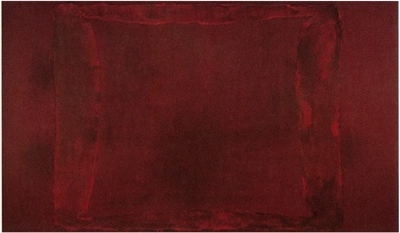Rothko’s Seagram Murals
July 19th, 2010
The seven of Mark Rothko’s Seagram Murals on exhibition at the Kawamura Memorial Museum of Art, reproduced in the museum’s 2009 Mark Rothko. My notes below, having recently visited.
Moving counter-clockwise from the entrance of the dedicated Rothko Room, these paintings seem to manifest a sequence of transcendental frictions.
Untitled, 1958 (p87). Click for larger version.
Brightly corporeal, the first painting’s frame conveys the physicality of unattended reality, while narrow ways provide an impetus to attendance.
Sketch for “Mural No.1”, 1958 (p89). Click for larger version.
Transcendental journey underway, the second painting unveils a horizon full of indistinct pattern as new eyes adjust to peering into depths.

Untitled, 1959 (p100-101, above from postcard).
Yet on approach, the third painting’s frame, darkest in the series, highlights sinister details, and our transcendent purpose is fearful and confused.

Mural, Section 1, 1959 (p98-99, above from postcard).
Attention is compelled inward as the fourth painting flatly reflects our judgment, a boundary between attendance of the world and ourselves.

Sketch for “Mural No.4”, 1958 (p90-91, above from postcard).
The fifth painting presents choice behind a living, ascending frame that is the consequence of reflection; the horror of the third painting recedes.
Mural Sketch, 1959 (p96). Click for larger version.
Painting six reveals the futility of many worlds as the colors of the frame and way begin to blur; in the lower left paint flows upwards.
Mural Sketch, 1958 (p88). Click for larger version.
The only blue in the series, iridescent and supernatural, paints the instrument of transcendence and frames realization; yet the way retains its color, and one is still, in the final painting, approaching.
Theories of Mind and Body Relationships
July 18th, 2010
A diagram from Odhams Press’s 1955 The Wonderful Story of You: How Your Body Works, How Your Mind Works.
 |
EPIPHENOMENALISM
Mind a mere by-product of body |
 |
PHYSICAL MONISM
Body a mere precipitate or condensation of mind |
 |
PARALLELISM
Mind and body on parallel lines, but no connection between them whatever |
 |
TWO ASPECT THEORY
Mind and body two aspects of the same reality |
 |
MATERIALISM
Body alone exists. Consciousness is merely a physiological process |
 |
SUBJECTIVE IDEALISM
Mental processes alone exist |
 |
INTERACTION
The view of Common Sense. Mind and body both exist and act and react one with the other |
“Obviously mind and body influence each other to a very great extent, and many theories have been put forward to explain how they are related. Some of the most important of these theories are illustrated in diagram form above” (p197).



